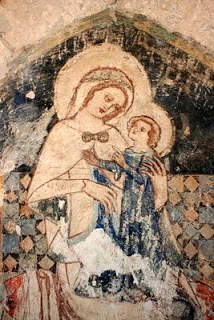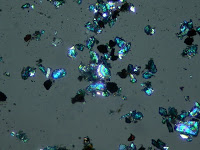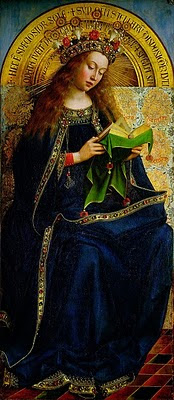Medieval History
 When the previously unknown fresco of the Virgin and Child was uncovered in the Inner City parish church of (Buda)Pest, the restorer and art historians alike were struck by the excellent preservation of large patches of azurite blue. The cloak of the Virgin and that of the Child is the same blue, and the background of the painting is painted with a darker shade of the same blue (azurite mixed with black). This find reminds us that during the Middle Ages, Hungary was one of the primary sources of azurite in Europe. The mineral (a copper-ore) came from the copper mines of northern Hungary, from places such as Rudabánya. It is well-known that ultramarine was the most expensive pigment in the Middle Ages - but it was very hard to get, and azurite was a good alternative. You can read about the pigment a lot, for example in Daniel V. Thompson's classic book on the Materials and Techniques of Medieval Painting.
When the previously unknown fresco of the Virgin and Child was uncovered in the Inner City parish church of (Buda)Pest, the restorer and art historians alike were struck by the excellent preservation of large patches of azurite blue. The cloak of the Virgin and that of the Child is the same blue, and the background of the painting is painted with a darker shade of the same blue (azurite mixed with black). This find reminds us that during the Middle Ages, Hungary was one of the primary sources of azurite in Europe. The mineral (a copper-ore) came from the copper mines of northern Hungary, from places such as Rudabánya. It is well-known that ultramarine was the most expensive pigment in the Middle Ages - but it was very hard to get, and azurite was a good alternative. You can read about the pigment a lot, for example in Daniel V. Thompson's classic book on the Materials and Techniques of Medieval Painting.

- The Ghent Altarpiece In 100 Billion Pixels
It is now possible to zoom into the intricate, breathtaking details of one of the most important works of art from the medieval world, thanks to a newly completed website focused on the Ghent Altarpiece. A stunning and highly complex painting composed...
- 14th Century Church Fresco Uncovered In Budapest
A Hungarian priest, Zoltán Osztie, and archaeologist Imre Bodor presented a rediscovered medieval fresco to the media on Thursday. The fresco, which portrays the infant Jesus and the Virgin Mary, was uncovered on a sanctum wall behind the main altar...
- Ancient Egyptian Blue Found In 12th Century Church
A team of researchers from the University of Barcelona has discovered remains of Egyptian blue in a Romanesque altarpiece in the church of Sant Pere de Terrassa in Barcelona. This blue pigment was used from the days of ancient Egypt until the end of the...
- Most Popular Posts On Medieval Hungary
The end of the year marks the end of my third year of blogging. Along the way, I have posted 120 posts on various topics related to Hungarian medieval art, which generated over 90.000 page views to this date. My blog was featured in several online journals...
- The Medieval Parish Church Of Pest (part Ii.) - A Remarkable Discovery
This post focuses on the medieval fresco decoration of the Inner City parish church of Pest - you can read my introduction to the history of the building here. Not much survived of the original painted decoration of the Inner City parish church....
Medieval History
Hungarian azurite

Paint samples have been analysed from the Budapest fresco, and beautiful microscopic photos of the pigment were made by restorer Éva Galambos - such as this one to the right.
 |
| The Virgin Mary from the Ghent Altarpiece |
Hungarian azurite sources became generally unavailable to Europe after the Ottoman Turks occupied much of the country during the 16th century. There is a classic story, reported among others by Karel van Mander, that reminds us of these historical circumstances. Around 1558, Michiel Coxie was making a copy of the Ghent altarpiece of Jan and Hubert van Eyck (the panels of which are today in Berlin and Munich), for Philip II of Spain (also the Duke of Flanders). As Karel van Mander tells us, Coxie fulfilled this commission admirably. Coxie, however, was unable to obtain azurite of suitable quality - Coxie explains that this type of azure pigment, a natural coloring, comes from some mountains of Hungary, and was easier to obtain earlier, before the country came under Ottoman rule. Coxie in the end was able to get the needed azurite on the order of the king directly from Titian, who still had some. Van Mander goes on to emphasize that only the azurite needed for the cloak of the Virgin was worth 32 ducats. Did Jan van Eyck use Hungarian azurite, too? The sources do not reveal this - but maybe the new technical examination of the Ghent altarpiece will provide some answers.
You can read van Mander's original text in the Het Schilder-boek, in the online edition of the Dutch Digital Library. The story is told in the Life of Jan and Hubert van Eyck.
(See also my previous posts on the history of the Inner City parish church, and on various wall-paintings inside that church.)
- The Ghent Altarpiece In 100 Billion Pixels
It is now possible to zoom into the intricate, breathtaking details of one of the most important works of art from the medieval world, thanks to a newly completed website focused on the Ghent Altarpiece. A stunning and highly complex painting composed...
- 14th Century Church Fresco Uncovered In Budapest
A Hungarian priest, Zoltán Osztie, and archaeologist Imre Bodor presented a rediscovered medieval fresco to the media on Thursday. The fresco, which portrays the infant Jesus and the Virgin Mary, was uncovered on a sanctum wall behind the main altar...
- Ancient Egyptian Blue Found In 12th Century Church
A team of researchers from the University of Barcelona has discovered remains of Egyptian blue in a Romanesque altarpiece in the church of Sant Pere de Terrassa in Barcelona. This blue pigment was used from the days of ancient Egypt until the end of the...
- Most Popular Posts On Medieval Hungary
The end of the year marks the end of my third year of blogging. Along the way, I have posted 120 posts on various topics related to Hungarian medieval art, which generated over 90.000 page views to this date. My blog was featured in several online journals...
- The Medieval Parish Church Of Pest (part Ii.) - A Remarkable Discovery
This post focuses on the medieval fresco decoration of the Inner City parish church of Pest - you can read my introduction to the history of the building here. Not much survived of the original painted decoration of the Inner City parish church....
